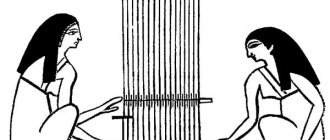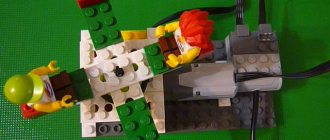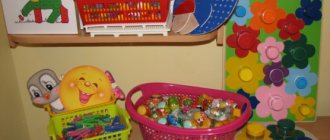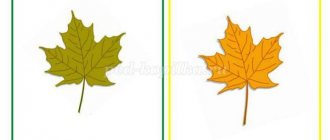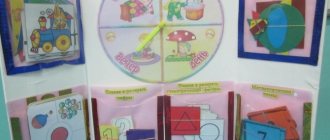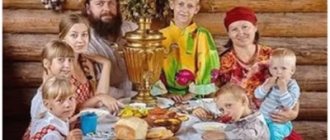Children's master class on manual labor “Didactic game “Magic Circle. Guess the fairy tale""
Morozova Marina Yurievna
Children's master class on manual labor “Didactic game “Magic Circle. Guess the fairy tale""
Materials for the master class : colored cardboard, a set of colored paper, scissors, glue stick, printouts depicting fairy-tale characters .
The master class was performed by the guys from the whole group in pairs.
At the preparatory stage of the master class, the guys cut out fairy-tale characters .
Nastya and Rodion carefully cut out the characters from the fairy tale .
Makar and Yegor carefully completed part of their work.
Martin and Zakhar took their task responsibly.
At the next stage, master class Makar and Rodion very carefully cut out two parts along the contour - round .
Rodion cut out a circle , divided into equal sectors. This is the base of " Magic Circle "
.
Makar carved a colorful rotating circle that overlaps the circle with sectors .
Developmental manual for speech development “Rings of Lull”
1. Photo of a developmental manual.
2. Description of the algorithm for producing the manual.
To make a manual, you need to take: two rectangular pieces of any solid material, for example: plexiglass, plywood, thick cardboard, plastic, a width equal to the diameter of your rings, and a length 2-4 cm less than two diameters of the rings. On the bottom plate, in the places of the supposed centers of the rings, it is necessary to strengthen the pins. Build a small side around the perimeter, and attach legs or hinges to the bottom side. It is necessary to cut out a window in the upper rectangle so that the combined pictures are visible. If the game will only stand on the table, then the lid can not be attached, but simply placed on the sides of the base. If the manual can be hung on the wall, the cover must be secured.
For free and convenient rotation of the rings, it is proposed to use a base in the form of old gramophone records. It is convenient to rotate the circles by the protrusions, which are formed as a result of the fact that the width of the aid is 2-4 cm less than two diameters of the plates.
3. Problems that this manual helps solve.
- develop phonemic processes;
- clarify and activate vocabulary;
- improve the syllabic structure of words;
- automate speech sounds;
- form the structure of sentences;
- improve the development of coherent speech.
This game guide can be used to reinforce articulation exercises, correct the sound side of speech, and for the development of lexical and grammatical categories and coherent speech.
4. Option for using the manual.
Games that improve the sound aspect of speech and literacy: “Sound Circles.” “Zvukariki”, “Where is the sound hidden?”
Purpose of the games:
- improving sound analysis skills
- literacy training
- expansion and activation of the dictionary
Description: Games are played in pairs or with a subgroup of children. On the 1st circle there are pictures with the image of “sound” (pump-S, mosquito-Z, bee-Zh, snake-Sh..), on the 2nd circle there is a picture and a sound diagram. According to the rules of the game, you need to match the picture “sound” with a picture with a diagram and determine the position of the sound in the word. You can replace pictures with sound patterns with letters and call the sound that lives in its apartment a letter. The degree of difficulty of tasks should increase gradually. Children accompany all their actions with speech, consolidating the skills of sound analysis and acquired knowledge of literacy.
Games for the formation of lexical and grammatical categories: “Whose, whose, whose?”, “Form a word”, “One is many”, “Name it”, “Count it”
Purpose of the games:
- improving the lexical and grammatical structure of speech
- strengthening the skills of word formation and inflection.
- expansion and activation of the dictionary
- development of coherent speech
Description: The organization and conditions of the games are the same. On the 1st circle there is a picture of an animal or bird, on the 2nd circle there are parts of its body (tail, paws, ears, nose, wings...) or cubs, or a habitat, or several animals and birds. Children, spinning circles, select a pair, consolidating knowledge about the animal world and lexical and grammatical categories that they met in a lesson with a speech therapist. These game exercises reinforce the formation of a coherent independent statement.
Games that improve the development of articulatory motor skills: “Tongue exercises”, “Look and show”
Purpose of the games:
- improving children's articulation abilities
- development of visual gnosis and constructive praxis
- developing cooperation and independence skills
Description: The game is played in pairs or two subgroups of children. Take circles 1 with a picture of an articulation exercise, 2 with pictures corresponding to an articulation exercise (fungus, swing, fence, watch, cup). A picture is installed in one of the windows, the pair of which is selected by scrolling the second ring. In these games, one picture of circle 1 must correspond to a picture of circle 2. Children, by finding and selecting pictures, simultaneously consolidate their skills in performing articulation exercises, name articulation exercises and consolidate the poems learned for this exercise.
Authors: Daniliva Olga Ivanovna, teacher-speech therapist; Shumilina Evgenia Nikolaevna, teacher; MBDOU d/s general developmental type No. 53, Volzhsky, Volgograd region, Russia.
The article is published in the author's edition
Educational didactic game “Magic Circle”
Alena Chumak
Educational didactic game “Magic Circle”
Presentation of the author's educational game
Author's full name: Chumak Alena Sergeevna
Name of preschool educational institution: “D/S “Nastenka”
Game name: " Magic Circle "
Children age group: 2-3 years
Goals: creating a social situation for the development of children in the process of cognitive and play activities “ Magic Circle ”
;
children's sensory abilities (ideas about color, shape, size)
.
1. create conditions for the formation of an idea about the game “ Magic Circle ”
;
2. create conditions for the development of thinking , auditory attention and active speech of children;
3. create conditions for familiarization with wild and domestic animals and their food;
4. create conditions for familiarization with different geometric shapes and colors;
5. create conditions for enriching and accumulating children’s sensory experience during object-based play activities through games with didactic material .
